Did you know a Rottweiler’s head shape can actually hint at its ancestry and working style?
That powerful skull wasn’t just bred for looks — it’s a leftover from centuries of guarding cattle and pulling carts across Europe.Pretty cool, right?
But here’s the fun part: that same head shape can also reveal a bit about your Rottie’s personality.
From the broad, “don’t-mess-with-me” types to the leaner, athletic ones, each head tells its own story.
Let’s unpack what your Rottweiler’s head type might say about who they are beyond just those impressive looks.
Understanding Rottweiler Head Types (In Plain English)
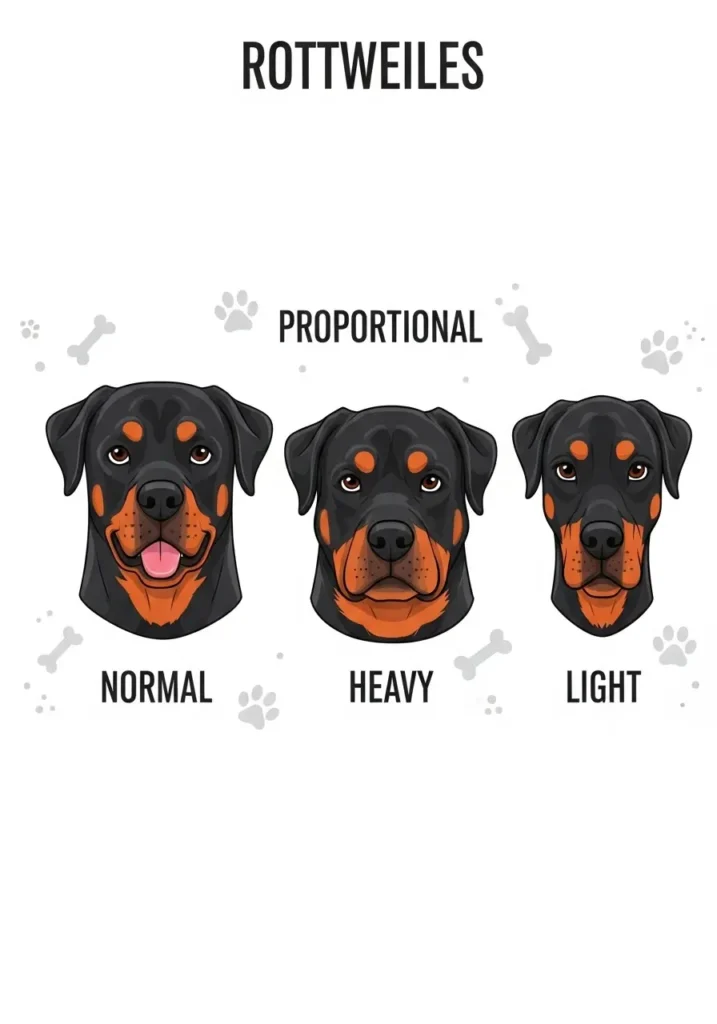
Alright, quick refresher. The Rottweiler head is one of the breed’s most defining features. That strong skull, wide jaw, and intense gaze? It’s what gives them that “I mean business” look.
But not every Rottie’s head looks the same. Breeders and enthusiasts usually describe four main head types: normal, proportional, heavy, and light.
Here’s what that means without the show-ring jargon:
1. Normal Head Type
- Balanced and classic.
- The skull and muzzle are in perfect proportion.
- The stop (the dip between the forehead and muzzle) is well-defined.
This is your “textbook Rottweiler” — confident, alert, and balanced both in looks and behavior. These dogs often have steady, even-tempered personalities. They’re confident without being cocky and protective without being pushy.
Think of them as the “ideal coworker” of the Rottie world — reliable, professional, and won’t steal your lunch.
2. Proportional Head Type
- Slightly shorter muzzle or wider skull than the normal type.
- Still balanced but just a bit more distinctive in shape.
These Rotties often have a curious, energetic vibe. They’re alert, sociable, and tend to be the first to check out what’s making noise in the backyard (probably a leaf, but hey, priorities).
IMO, Rotties with proportional heads are the ones who love being involved — training, playing, or just following you to the bathroom for moral support.
3. Heavy Head Type
- Big, broad skull with a deep stop.
- Strong muzzle that screams “I can move mountains.”
The heavy-headed Rottie is your gentle giant. They look intimidating but usually have a calm, composed energy. These dogs are often the quiet observers — they watch, assess, and act only when necessary.
They tend to bond deeply with their family, showing affection in that “I’ll sit on your foot so you can’t leave” kind of way. ❤️
4. Light Head Type
- Slimmer skull, less pronounced stop, longer muzzle.
- Sleeker, more athletic appearance.
These Rotties are usually quick, agile, and curious. They might have a slightly softer expression, and their personality often matches — alert, playful, and very people-oriented.
If you’ve got a light-headed Rottie, you probably have a dog who’s a bit of a charmer. They may not look as “macho,” but they’ll win hearts faster than a heavy-headed one can growl.
Male vs Female Rottweiler Head Types (And Personalities)
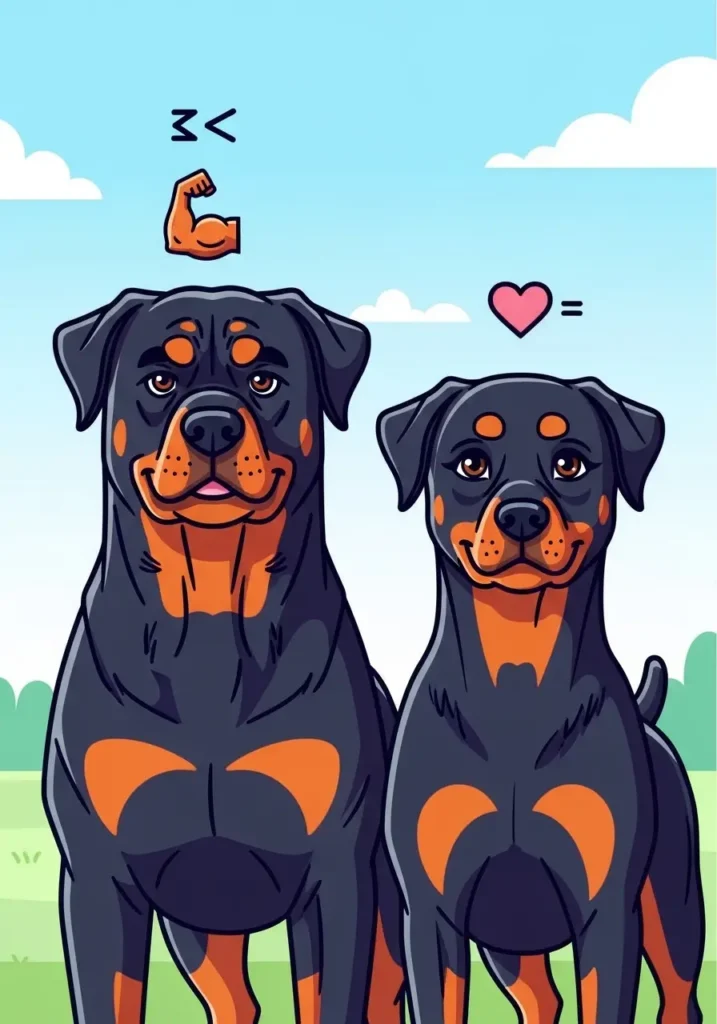
Okay, let’s be honest — male and female Rotties can look like they belong to two different gym memberships. 😄
Males
- Heads: Bigger, blockier, more muscular.
- Expression: Bold and commanding.
- Vibe: Confident, protective, sometimes a bit stubborn (sound familiar?).
Male Rotties tend to have that “I got this” attitude. They’re loyal to the core and often take their guardian role very seriously. But they can also be giant toddlers when they want attention — drool and all.
Females
- Heads: Softer, narrower, more refined.
- Expression: Gentle yet sharp (don’t mess with them though).
- Vibe: Intelligent, focused, and emotionally intuitive.
Female Rotties are like the quiet strategists. They’re affectionate but cautious, playful but always watching. They often read your mood faster than your best friend does.
Bottom line? Head shape reflects energy, not dominance. Male heads tend to project strength, while female heads highlight sensitivity and alertness. Both are brilliant — just in different ways.
German, American & Roman Rottweiler Heads (And What They Hint At)
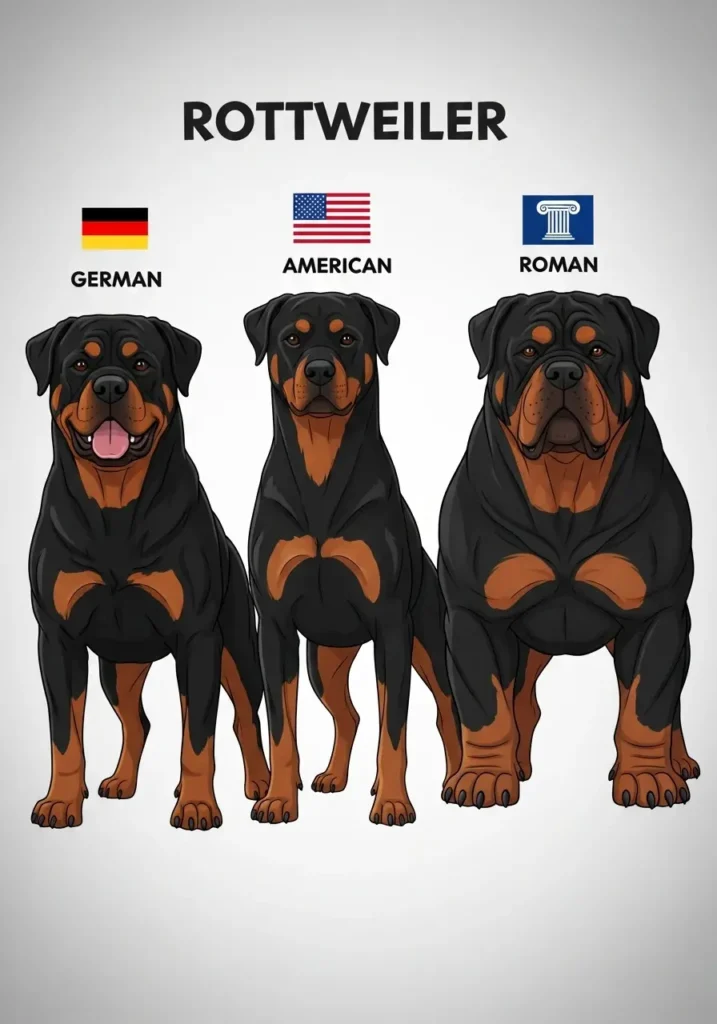
Ever heard someone brag, “Mine’s a German Rottweiler”? Well, here’s a fun fact — German, American, and Roman Rottweilers aren’t technically separate breeds, but their breeding standards and looks do differ. And yes, head shape plays a big role.
German Rottweiler
- Broad, blocky head.
- Deep stop, strong jawline.
- Overall heavier build.
German Rotties often look (and act) serious. They were bred to work — pulling carts, guarding homes, protecting livestock. That determined look on their face? Totally earned.
Their personality matches their head: confident, calm, and grounded. They’re thinkers before they’re barkers.
American Rottweiler
- Slightly narrower head.
- More athletic build.
- Refined, less bulky appearance.
American Rotties tend to be a little more active and expressive. They love running, playing fetch, and keeping busy. That narrower head reflects agility and energy — like the difference between a heavyweight boxer and a sprinter.
They’re often more outgoing and social, too. You’ll probably catch them trying to greet every neighbor within a mile radius.
Roman Rottweiler
- Huge, broad skull with visible wrinkles.
- Deep, soulful eyes.
- Think: “Gentle giant with a teddy bear heart.”
Roman Rottweilers are big, powerful dogs, but their demeanor can be incredibly loving. Their large heads might give off “tough guy” vibes, but in reality, they’re usually sweet, loyal, and protective in a calm, almost regal way.
Their personality screams: “I’ll guard you, but also let’s nap right here.”
Can Head Type Really Affect Personality?
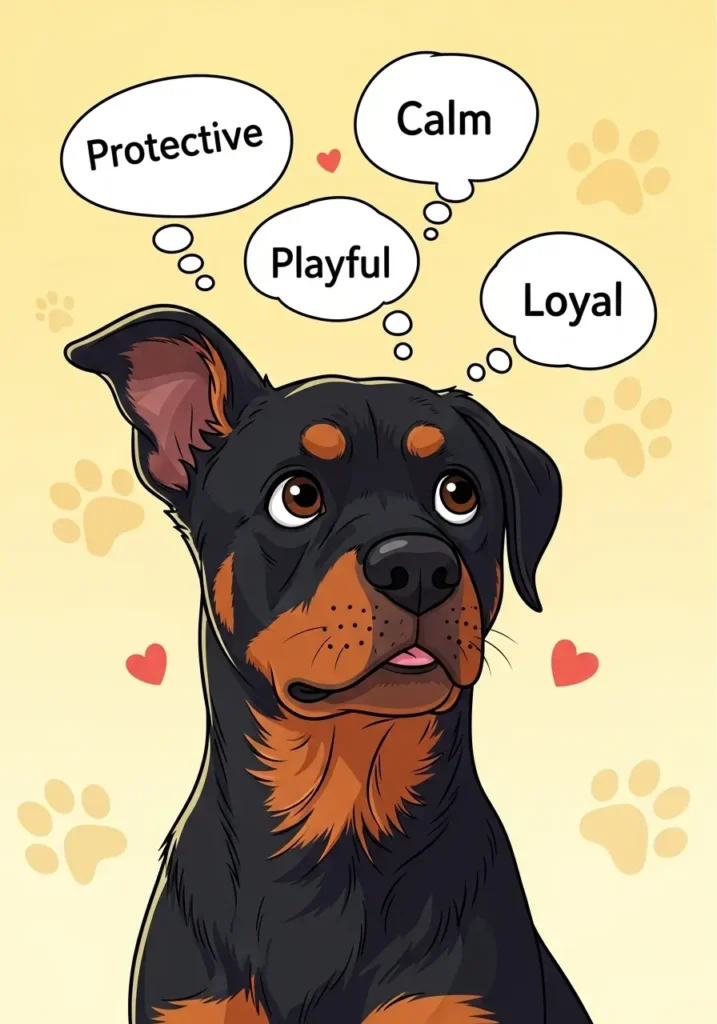
Here’s the million-dollar question: does a Rottweiler’s head type actually determine their personality?
Short answer: Not exactly.
Long answer: It can reflect tendencies shaped by breeding lines and physical traits.
For example:
- Heavy heads often come from working lines, where calmness and strength were valued.
- Light heads sometimes show up in more athletic, energetic lines.
- Balanced heads usually point to strong breed standard breeding — calm, confident, stable temperaments.
But the real factors shaping your dog’s personality?
- Early socialization
- Consistent training
- And (of course) how you treat them
You can’t blame the head if your Rottie chews your shoes. That’s on you, my friend. 😉
What Your Rottweiler’s Head Might Reveal About Their Behavior
Let’s connect a few dots here — not scientifically, but from years of living with and around Rotties:
| Head Type | Typical Look | Common Personality Traits |
|---|---|---|
| Normal | Balanced, broad skull, medium muzzle | Calm, confident, dependable |
| Proportional | Slightly shorter muzzle, broader skull | Alert, curious, active |
| Heavy | Large, wide skull, deep stop | Steady, protective, loyal |
| Light | Narrower skull, longer muzzle | Energetic, affectionate, playful |
Of course, every Rottie is an individual — just like every human with a different hairstyle or shoe size.
But here’s what’s fascinating: many owners find that heavier-headed dogs tend to be more laid-back and steady, while lighter-headed ones are livelier and quicker to react.
Coincidence? Maybe. But after meeting dozens of Rotties, I’m not so sure.
How to Tell What Head Type Your Rottweiler Has
Curious about your own dog? Here’s a quick checklist:
Look from the side:
- A deep stop (that forehead dip) usually means heavier head type.
- A gentle slope means lighter or proportional type.
Look from above:
- A wider, more rectangular shape? Heavy or normal.
- A narrower, triangular shape? Light or proportional.
Look at the muzzle:
- Short and wide: Heavy.
- Medium and balanced: Normal.
- Longer and finer: Light.
FYI — head shape can keep changing slightly until about two years of age, especially in males. So if your pup’s features still look “awkward,” relax. They’re still growing into their big Rottie head. 🙂
Why This Stuff Actually Matters
You might be wondering, “Okay, this is cool trivia, but does it really matter?”
Yes — and here’s why:
- Understanding temperament: Knowing the general tendencies of different head types helps you predict how your Rottie might react in certain situations.
- Better training approach: A heavier-headed, calmer dog might need patience and gentle reinforcement. A lighter-headed, energetic one may thrive on variety and play.
- Breeding and adoption insight: If you’re adopting or choosing a pup, recognizing head type gives you clues about lineage and likely temperament.
Basically, it’s not about vanity — it’s about connection. The more you understand your dog’s build, the better you can communicate, train, and bond.
Common Myths About Rottweiler Head Types
Let’s bust a few myths while we’re at it:
- “Bigger head = better Rottweiler.” Nope. A large head doesn’t mean better temperament, intelligence, or loyalty.
- “Roman Rottweilers are a different breed.” They’re not. It’s just a nickname used for large-headed, heavy-boned Rotties.
- “Light-headed Rotties are weak.” Also false. They’re often faster and more agile — just built differently.
Don’t get caught up in head-size hype. What matters most is health, temperament, and proper care.
Final Thoughts: The Head Says a Lot — But Not Everything
Your Rottweiler’s head is more than just an impressive feature — it’s part of a long history of strength, intelligence, and loyalty.
Whether your Rottie has a heavy, broad skull that commands respect or a sleek, refined head that gives off charm, the truth is simple: each type carries its own beauty and personality.
At the end of the day, your dog’s head type might give you clues, but it’s your bond, training, and love that define who they are.
So next time your Rottweiler rests that big head on your lap, take a moment to appreciate it — that’s centuries of breeding, purpose, and devotion rolled into one look. And yeah, maybe a hint of “feed me already.” 🐾
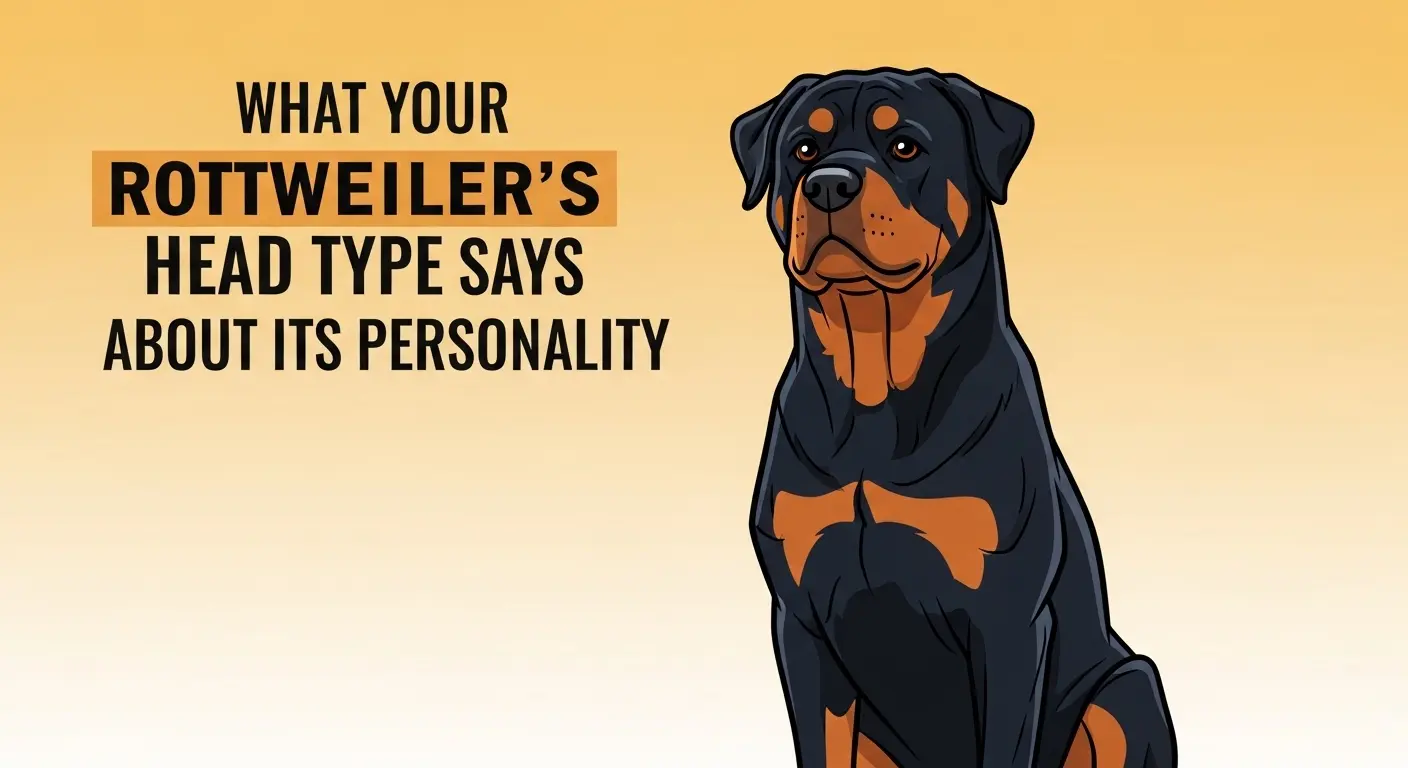
Totally enjoyed this read. Thank you!
Thanks! Super cute article and love the way it’s written. My baby is German rottie with a noraml head. Shes the best.
Aww, thank you! 😊 German Rotties are incredible—strong, loyal, and just a bit softer in temperament than the Roman types. And that “normal head” look is actually closer to the original breed standard. Sounds like you’ve got a perfect companion on your hands! Give her some extra ear scratches from me. 🐾